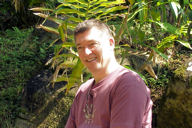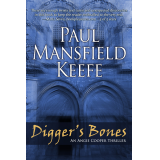The wheels of Angie’s 727 touched down on the western most runway at Dulles International. She would take her find, left at the top of Bandelier, directly to Dr. Lausen. She didn’t miss driving the Capital Beltway from her days working in D.C.; it’s the worst traffic in Virginia. The Mt. Vernon Parkway is a far more picturesque, scenic drive. It meanders along the beautiful Potomac River, flowing with its natural curves. Angie made her way into one of the many sprawling neighborhoods of Mt. Vernon. She found the house she was looking for, a place she hadn’t laid eyes on in many years, and pulled into the driveway.
The house—and the hefty mortgage that came with it—belonged to Dr. Christopher Lausen, Professor of Mythology at Georgetown University, Angie’s former mentor during his tenure at Columbia as Professor of Archaeology, a multi-talented man with a diverse interest. Angie rang the bell; half hoping he wouldn’t be home after all that went down in Hoi Oidak.
The door opened, “Angie!” Dr. Lausen’s eyes brightened as he saw her standing on his front steps. He grabbed her, hugging her hard.
“I came directly here,” she said.
“Yes, yes, come in, come in.” He ushered her into the foyer. “Reilly’s already here.”
Angie froze in her tracks. She was overtaken with emotions. Emotions she successfully buried for the past two years.
“Hey, Ang.”
It was him, Jack Reilly. He moved toward her with the same confidence and natural swagger that attracted her to him in the first place. Dark brown hair rested across golden brown eyes only to be flung back with an easy toss of his head. He hugged her, and she melted into his hug, a comfortable and familiar feeling. The days she spent in his arms came rushing back into her head like the bursting of a dam. Three years she wished had gone on forever. Three years that ended with her once promising career. Her mind flashed back to that awful day, the day of his betrayal. She pushed him away, but he held her at arm’s length.
“Let go of me,” she managed to whisper, not sure how much she meant it.
“I heard about Digger.” The tears welled up in his eyes and Angie let go as well. How could she still hate him after all this time? After what had happened to their friend, Digger? She remembered how close Reilly and he were, and she simply broke down and sobbed. He held her tightly, letting the emotions drain away as spring’s thaw in a mountain stream. She felt whole again.
Pushing him away a final time she rubbed her nose and sniffled, starting for the kitchen. “He left a flash drive.”
“Angie, you know Madison.” Dr. Lausen bent his head toward the mousy girl in the black jeans and t-shirt leaning against the kitchen counter.
“Madie!” Angie ran to her and hugged her like she was a long lost child. And, in some sense, she was. Madison Rothschild, eighteen year old daughter of one of Angie’s mentors, murdered by a white haired hired gun. They had known each other since Madison was a kid. The professor would bring her on digs hoping to peak her curiosity for his beloved profession. Angie filled the void of the sister Madison never had and the mother she never knew.
Angie pushed the bangs of Madison’s black hair that had fallen from her loose French twist out of her face. “I’m so sorry, Madie.”
Tears flooded Madison’s eyes until the levy broke and they rolled down her cheeks like tumultuous rivers. Her body shook and convulsed violently with every sob. “I still can’t believe it.”
Angie held her until the shaking ceased. Quieting her with gentle shushes.
Red, swollen eyes turned up to Angie. “I can’t believe he’s gone. What am I going to do?”
“I don’t know. But you know that I’m here for you. I promise, anything you need, Madie, I’m here for you.”
Madison pulled away from Angie. It had been several years since Angie last saw her; she was no longer a child and had become far more independent.
“Ang?”
“Yeah?”
“You lost your father didn’t you?”
“Yeah.” Angie swallowed hard. “But it was a long time ago. I was only a kid.”
Between sobs Madison asked, “Do you miss him?”
“Terribly.”
Although it would seem the wrong thing to say to a grieving daughter, it had a positive effect. Madison wiped at her nose and dried her tears, smiling at Angie in a way that expressed their kinship. Reilly set up his laptop in Lausen’s dining room and Angie sat down beside him. Madison and Dr. Lausen peered in over their shoulders. After a few moments Reilly had the flash drive loaded onto the desktop.
“Looks like photos.” Digger was a bit of a photography nut, a self-proclaimed artist. Reilly double-clicked the first one and it opened into his photo viewer. It was a picture of Digger. He quickly clicked the next button only to be shown a photo of Professor Rothschild. He clicked again before it seared its way into Madison’s fragile psyche. A photo of a young woman none of them knew came next. He clicked again and again, the rest of the photos were a mix of odd subjects, a large cross within a church, a stained glass window, a sconce lamp on the side of a building, a white portico, an orange locker key, a car’s windshield, two hands shaking, several photos of a tomb.
The most interesting photos—somewhat grainy from low light, but still clear enough to make out—were of a rolling-stone tomb door and a skeleton in a sitting position. The stone looked large, maybe six feet from edge to edge, flat on the front and back like an enormous wheel. It was rolled to the side revealing the dark of the tomb beyond. The skeleton’s legs and arms were crossed as if in meditation.
“Weird,” mumbled Reilly. “It’s just an ordinary dig. No pottery. No real architectural interest. There’s nothing of significance that I can see, other than the rolling-stone door.”
“Even the door isn’t that unique,” added Dr. Lausen.
Reilly was right, it was an ordinary dig. A small cave with a slab or bed in the back, dug out from the side of the hill. A weathered stone rolled most of the way over the entrance. The photos seemed rather ordinary.
“There has to be something here,” Angie said. “We’re obviously missing something. Digger and the professor were killed for a reason.” She rubbed the side of her face where Tek had kicked her and looked anxiously at Madison.
“Wait,” said Madison, pointing at the stone door, “is that writing?”
Reilly zoomed into an area of the stone door at the entrance.
Dr. Lausen put his reading glasses on and leaned into the computer’s screen. “It’s an Aramaic inscription, Hebrew.”
“Can you read it?” Angie bit her lip as she waited for his reply.
“My Hebrew is a bit rusty but, I think it says ‘Judah’.”
“Judas,” Angie said, lifting her head off her hands excitedly.
“Yes, of course,” said Dr. Lausen. “The professor had a lifelong interest in looking for the burial tomb of Judas. I didn’t know he was actively pursuing it. But then again, I guess he always has been. At least as long as I’ve known . . . knew him.”
Madison grimaced.
Angie pointed at the screen. “But, I thought Judas would have been buried in a mass grave? That is certainly a single tomb, maybe large enough for a family, but that’s about it.”
“Well,” Madison chimed in, “no one knows for sure, Angie. My father certainly didn’t believe in a mass grave. The Gospel according to Matthew says that Judas committed suicide and the thirty pieces of silver were used to buy a field as a burial site. But the Acts of the Apostles claim he bought the field himself and then he simply burst apart . . . I don’t know, something like that.”
Lausen studied her over his glasses. “Quite right, Madison. It would seem an unlikely ending of course, but perhaps more an exaggeration of the circumstances of his demise not of the location.”
Reilly, who hadn’t said much up to this point, added, “The Field of Blood.”
Angie looked fondly at Reilly. She thought back to when they first met, how impressed she was with his in-depth knowledge of seemingly archaic matter. He had a head for details that made him shine in her eyes. She realized she was starting to warm to him; not ready for that yet, she forced down a smile and turned away.
“Yes,” continued Dr. Lausen. “The Field of Blood, Akeldama, but there’s no tomb at Akeldama. So the question is: where were the photos taken?”
“And more importantly,” Reilly said, “where is the ossuary?”
Reilly hit the nail on the head, it was an important question. Where was the ossuary? Jerusalem was filled with tombs just like this one. But the deceased were buried in temporary graves, left until the flesh was gone from them. Then their bones were transferred to an ossuary. Made from wood or limestone they served the purpose of collecting the bones of the dead, mostly to make room for more. Whole families might share a tomb over generations, placing their loved ones bones into many ossuaries. Many believed the ritual of moving the bones to an ossuary was the only way to ensure the individual would be resurrected when the Messiah came to usher the righteous to heaven.
Angie looked down, deep in contemplation. “There’s no ossuary because no one intended to collect his bones!” The others looked at her bewildered. “Don’t you see? An ossuary is a container used to collect the bones of the dead to make room for more; that’s common knowledge. But many believed an ossuary was essential to being resurrected. And Judas wasn’t exactly on the path to heaven.”
“Very good, Angie,” said Dr. Lausen, he smiled proudly at his former student. “I think we can assume this is one forgotten soul. And therefore it is likely, at least it would seem so in the professor’s mind, that these were the bones of Judas. And this tomb, his final resting place. So, at least that puts us in Israel, most likely Jerusalem.”
Madison pulled at her face. “I can get all his old research on Judas, it’s at the house. I mean, if you want me to.”
Angie held her hand, “Do you need me to go with you?”
Madison pulled her hand back. “No, I’m fine. I can do it. I’ll bring it back in the morning.”
They flipped through the photos several more times, but found nothing new in them.
“Go back to that photo of Digger,” said Dr. Lausen. Reilly thumbed back through the files until he came to the first. Angie looked away suppressing her anguish.
“Just as I thought,” he said, “that’s Jerusalem.” The other three turned toward him questioningly. “It’s the David Citadel Hotel, there in the background. I’ve stayed there on occasion.”
Lausen pulled off his glasses and turned to Madison. “Madison, you have a passport, correct?”
Angie’s face brightened at the thought of adventure, traveling the world in an effort to uncover some long hidden treasure. They would go to Jerusalem, and they would find Digger’s bones. And maybe—just maybe—Angie would get her career back.
Archive for February, 2011
Cryptic Photographic Clues
Sunday, February 27th, 2011burst out – a micropoem
Monday, February 21st, 2011When the devil comes to collect my bones
Sunday, February 20th, 2011When the devil comes to collect my bones
Tell him the marrow has dried and blown to the winds
Tell him you saw my shadow up amongst the stars
Fleeting and quivering like a dying sun
Tell him you saw the oceans form from my tears
My blood flowing down mountain streams
Tell him you heard the wind call my name
Lonely and untamed
And when the sun comes to rise upon my grave
Tell him all the flowers have gone back to the earth
Tell him you saw my shadow up amongst the stars
Playing out one last fleeting memory of my supernova life
Tell him you were my friend and I let you down
And let my spirit live on in perpetual loneliness
Cathedra Petri
Sunday, February 20th, 2011Pale moonlight sliced through night’s cold darkness. The eerie rays, colored by the stained glass window—a dove as Holy Spirit surrounded by 12 rays representing the apostles—fell dimly upon the anterior of the Cathedra Petri, The Chair of St. Peter, Gian Lorenzo Bernini’s masterpiece. The chair, or throne as many Christians see it, is encased in gilt bronze. St. Ambrose and St. Augustine, considered the fathers of the Latin Church, stand on the right of the chair. Fathers of the Greek church, St. Athanasius and St. John Chrysostom, stand to the left. The top of the chair, adorned with cherubim, cast grotesque shadows upon five cardinals meeting in secrecy below.
“Cardinal DiMarco, we have already let this go too far.” Cardinal Conti was the youngest, and therefore the least powerful, of the collected cardinals. He was also a sickly man, weighing no more than a hundred and forty pounds at almost six feet tall. He coughed far too much for a man of only forty five.
“How is it possible to go too far to protect St. Peter’s Church? Brother Elias has already found the tomb. He is but one step away from ensuring the future of the Sancta Sedes.” Cardinal DiMarco made no effort to hide his disdain. He did, however, hide the fact that he agreed.
He stood in the middle of the four cardinals, the subject of their ad hoc inquisition. It was up to him to convince the tribunal of four that Brother Elias’ actions were warranted. He had, after all, killed two priests in his quest for answers, murdering them in a most gruesome manner. Killing priests put the cardinals on edge; how far would this brother go to complete his mission?
Cardinal Moretti’s red robes rustled. He was an average sized man with an unremarkable face, the type whose nationality was hard to guess at. “Cardinal DiMarco, I believe what our good friend, Cardinal Conti, is saying is that,” he paused and looked over his shoulder before continuing in a whisper, “the taking of life is simply unacceptable. This brother has gone too far. He could bring us all down. Bring down the Holy See itself. There has to be another way to get the information we seek.”
Cardinal Moretti, only two years Cardinal DiMarco’s senior, had the ear of Cardinal Rossi. Rossi, at eighty nine years of age, had the final word in all such matters. Convincing him to ignore Moretti’s advice would be difficult at best. Cardinal DiMarco needed to collect his wits, to lay out a reasoned summation that was incontestable. After all, he had as much chance as any of them at the next Conclave to be elected the Bishop of Rome, the Pope. He took a few moments to breathe deeply and say a prayer before answering Conti’s argument.
“The Roman Catholic Church serves one purpose and one purpose alone. To ensure the children of God are brought into the fold and are directed down the path to His Kingdom. The job of the Holy See is to continue St. Peter’s mission on earth, a mission given to Peter by Jesus himself. A mission to ensure the path to Heaven remains open. Brother Elias’ job is to ensure that a barricade to the path cannot be erected. Yes, he needs direction. Yes, it could be argued, that less, shall we say, invasive techniques would be appropriate. But he must not be stopped. He must complete his mission or the church—no, dare I say all of Christianity—will fall. Even if we must risk our own admittance to the Kingdom of God, then so be it.” Cardinal DiMarco’s voice rang out upon the empty pews of the chapel.
Several moments passed without comment. Then, Cardinal Rossi wheeled his chair close to Cardinal DiMarco. His pale, liver-spotted head had only a few white hairs that sprouted seemingly randomly. He twisted an arthritic neck to the side so he could look up from his ever declining posture. His tortured face took on an even greater scowl. Then he spoke the deciding opinion.
“Continue.”








